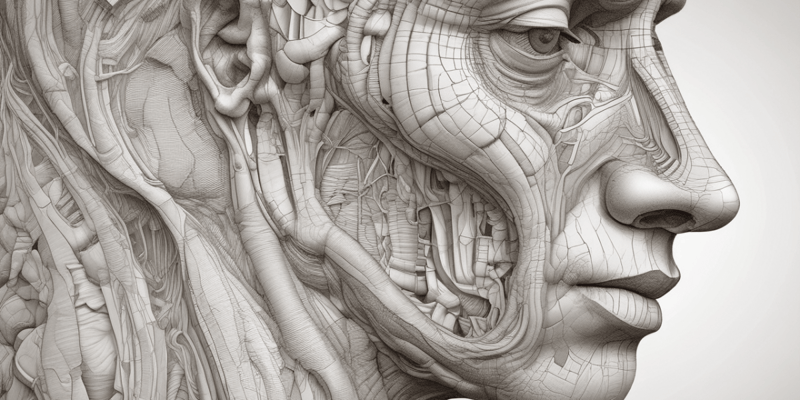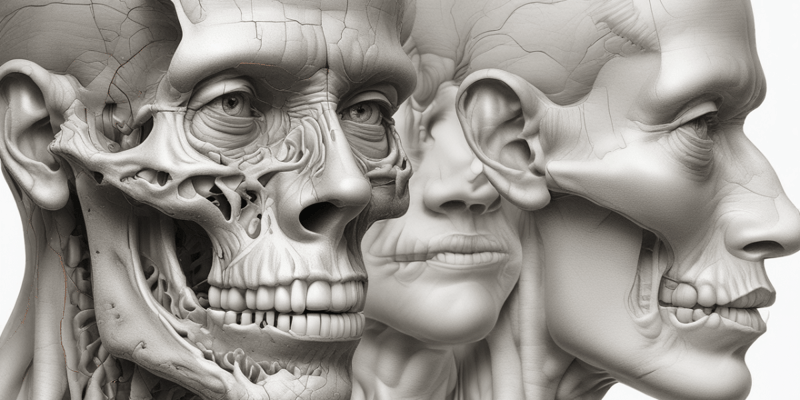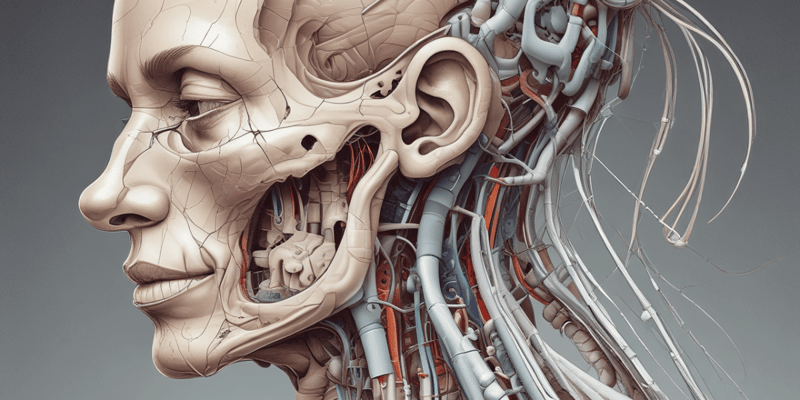Podcast
Questions and Answers
What is the primary function of the nose in relation to breathing?
What is the primary function of the nose in relation to breathing?
What type of epithelium lines the nasal cavity?
What type of epithelium lines the nasal cavity?
Which of the following bones forms the boundary of the nasal cavity?
Which of the following bones forms the boundary of the nasal cavity?
What is the function of the conchae in the nasal cavity?
What is the function of the conchae in the nasal cavity?
Signup and view all the answers
What is the source of the blood supply to the nose?
What is the source of the blood supply to the nose?
Signup and view all the answers
What is the purpose of the nasal septum?
What is the purpose of the nasal septum?
Signup and view all the answers
What is the relationship between the paranasal sinuses and the nasal cavity?
What is the relationship between the paranasal sinuses and the nasal cavity?
Signup and view all the answers
What is the significance of the nerve supply to the paranasal sinuses?
What is the significance of the nerve supply to the paranasal sinuses?
Signup and view all the answers
What is the origin of the general sensory supply to the nose?
What is the origin of the general sensory supply to the nose?
Signup and view all the answers
What separates the left and right nasal cavities?
What separates the left and right nasal cavities?
Signup and view all the answers
What is the function of the olfactory region?
What is the function of the olfactory region?
Signup and view all the answers
What is the name of the three large elevations that protrude from the lateral wall of the nasal cavity?
What is the name of the three large elevations that protrude from the lateral wall of the nasal cavity?
Signup and view all the answers
What drains into the lateral walls of the nasal cavity?
What drains into the lateral walls of the nasal cavity?
Signup and view all the answers
What is the function of the nasal cavity?
What is the function of the nasal cavity?
Signup and view all the answers
What is the name of the foramen that connects the nasal cavity to the pterygopalatine fossa?
What is the name of the foramen that connects the nasal cavity to the pterygopalatine fossa?
Signup and view all the answers
What is the purpose of studying the paranasal sinuses?
What is the purpose of studying the paranasal sinuses?
Signup and view all the answers
Which nerve supplies the frontal sinus?
Which nerve supplies the frontal sinus?
Signup and view all the answers
What is the term for inflammation of the paranasal sinuses?
What is the term for inflammation of the paranasal sinuses?
Signup and view all the answers
Why can maxillary sinus infections cause toothache?
Why can maxillary sinus infections cause toothache?
Signup and view all the answers
What is the term for when more than one sinus is affected by infection?
What is the term for when more than one sinus is affected by infection?
Signup and view all the answers
How do infections of the upper respiratory tract spread to the paranasal sinuses?
How do infections of the upper respiratory tract spread to the paranasal sinuses?
Signup and view all the answers
Why can infection of the maxillary sinus spread to the upper teeth?
Why can infection of the maxillary sinus spread to the upper teeth?
Signup and view all the answers
What is the name of the tube that connects the middle ear and upper respiratory tract?
What is the name of the tube that connects the middle ear and upper respiratory tract?
Signup and view all the answers
What is the result of infection of the auditory tube?
What is the result of infection of the auditory tube?
Signup and view all the answers
What is the primary function of the turbinates?
What is the primary function of the turbinates?
Signup and view all the answers
Where does the ostia for the maxillary sinus open?
Where does the ostia for the maxillary sinus open?
Signup and view all the answers
Why is the maxillary sinus most likely to be infected?
Why is the maxillary sinus most likely to be infected?
Signup and view all the answers
What type of epithelial lining is found in the respiratory region of the nasal cavity?
What type of epithelial lining is found in the respiratory region of the nasal cavity?
Signup and view all the answers
Which structure marks the opening of the frontal, maxillary, and anterior ethmoidal sinuses in the nasal cavity?
Which structure marks the opening of the frontal, maxillary, and anterior ethmoidal sinuses in the nasal cavity?
Signup and view all the answers
Which cranial bone does the cribriform plate belong to?
Which cranial bone does the cribriform plate belong to?
Signup and view all the answers
Which bone is an unpaired bone of the nasal septum?
Which bone is an unpaired bone of the nasal septum?
Signup and view all the answers
Which of the following is the largest of the paranasal sinuses?
Which of the following is the largest of the paranasal sinuses?
Signup and view all the answers
Which facial bone forms the posterior aspect of the nasal septum?
Which facial bone forms the posterior aspect of the nasal septum?
Signup and view all the answers
What is the most common cause of nasal fractures?
What is the most common cause of nasal fractures?
Signup and view all the answers
Which paranasal sinus provides access to the pituitary gland?
Which paranasal sinus provides access to the pituitary gland?
Signup and view all the answers
What is the most common cause of epistaxis in a 22-year-old man?
What is the most common cause of epistaxis in a 22-year-old man?
Signup and view all the answers
Which type of injury is most likely to cause a nasal fracture?
Which type of injury is most likely to cause a nasal fracture?
Signup and view all the answers
What is the most common location for nasal fractures?
What is the most common location for nasal fractures?
Signup and view all the answers
What is the primary surgical approach to access the pituitary gland?
What is the primary surgical approach to access the pituitary gland?
Signup and view all the answers
What is the most common symptom of a pituitary adenoma?
What is the most common symptom of a pituitary adenoma?
Signup and view all the answers
What is the main function of the nasal cavity?
What is the main function of the nasal cavity?
Signup and view all the answers
What is the location of the olfactory region in the nasal cavity?
What is the location of the olfactory region in the nasal cavity?
Signup and view all the answers
What is the function of the nasal cavity?
What is the function of the nasal cavity?
Signup and view all the answers
Which bone forms the boundary of the nasal cavity?
Which bone forms the boundary of the nasal cavity?
Signup and view all the answers
What is the function of the conchae in the nasal cavity?
What is the function of the conchae in the nasal cavity?
Signup and view all the answers
What is the purpose of the conchae in the nasal cavity?
What is the purpose of the conchae in the nasal cavity?
Signup and view all the answers
What is the source of the blood supply to the nose?
What is the source of the blood supply to the nose?
Signup and view all the answers
What is the significance of the nasal septum?
What is the significance of the nasal septum?
Signup and view all the answers
What is the name of the foramen that connects the nasal cavity to the pterygopalatine fossa?
What is the name of the foramen that connects the nasal cavity to the pterygopalatine fossa?
Signup and view all the answers
What is the structure that separates the left and right nasal cavities?
What is the structure that separates the left and right nasal cavities?
Signup and view all the answers
What is the origin of the special sensory supply to the nose?
What is the origin of the special sensory supply to the nose?
Signup and view all the answers
What is the relationship between the paranasal sinuses and the nasal cavity?
What is the relationship between the paranasal sinuses and the nasal cavity?
Signup and view all the answers
What is the relationship between the nasal cavity and the paranasal sinuses?
What is the relationship between the nasal cavity and the paranasal sinuses?
Signup and view all the answers
What type of epithelium lines the nasal cavity?
What type of epithelium lines the nasal cavity?
Signup and view all the answers
What is the purpose of studying the nasal cavity and paranasal sinuses?
What is the purpose of studying the nasal cavity and paranasal sinuses?
Signup and view all the answers
What is the function of the nasal cavity in relation to the lacrimal duct?
What is the function of the nasal cavity in relation to the lacrimal duct?
Signup and view all the answers
What is the nerve supply of the ethmoidal and sphenoidal sinuses?
What is the nerve supply of the ethmoidal and sphenoidal sinuses?
Signup and view all the answers
Why can sinusitis cause pain and swelling?
Why can sinusitis cause pain and swelling?
Signup and view all the answers
What is the significance of the alveolar process of the upper molar teeth being close to the floor of the maxillary sinus cavity?
What is the significance of the alveolar process of the upper molar teeth being close to the floor of the maxillary sinus cavity?
Signup and view all the answers
What is the result of infection of the auditory tube?
What is the result of infection of the auditory tube?
Signup and view all the answers
What is the primary function of the paranasal sinuses?
What is the primary function of the paranasal sinuses?
Signup and view all the answers
What is the path by which infection can spread between the middle ear and upper respiratory tract?
What is the path by which infection can spread between the middle ear and upper respiratory tract?
Signup and view all the answers
What is the nerve that is affected by the swelling and direct pressure of the maxillary sinus?
What is the nerve that is affected by the swelling and direct pressure of the maxillary sinus?
Signup and view all the answers
What type of epithelium lines the paranasal sinuses?
What type of epithelium lines the paranasal sinuses?
Signup and view all the answers
Why is the maxillary sinus at risk of infection?
Why is the maxillary sinus at risk of infection?
Signup and view all the answers
Which artery supplies the frontal sinus?
Which artery supplies the frontal sinus?
Signup and view all the answers
What is the term for the openings that connect the paranasal sinuses to the nasal cavity?
What is the term for the openings that connect the paranasal sinuses to the nasal cavity?
Signup and view all the answers
What is the significance of the connection between the paranasal sinuses and the nasal cavity?
What is the significance of the connection between the paranasal sinuses and the nasal cavity?
Signup and view all the answers
Which nerve supplies the maxillary sinuses?
Which nerve supplies the maxillary sinuses?
Signup and view all the answers
What is the structure that marks the opening of the frontal, maxillary, and anterior ethmoidal sinuses?
What is the structure that marks the opening of the frontal, maxillary, and anterior ethmoidal sinuses?
Signup and view all the answers
What is the primary blood supply to the nasal cavity?
What is the primary blood supply to the nasal cavity?
Signup and view all the answers
What is the term for the process by which the paranasal sinuses form?
What is the term for the process by which the paranasal sinuses form?
Signup and view all the answers
What is the function of the turbinates?
What is the function of the turbinates?
Signup and view all the answers
Which cranial bone does the cribriform plate belong to?
Which cranial bone does the cribriform plate belong to?
Signup and view all the answers
Which of the following bones makes up the nasal septum?
Which of the following bones makes up the nasal septum?
Signup and view all the answers
What is the epithelial lining of the respiratory region of the nasal cavity?
What is the epithelial lining of the respiratory region of the nasal cavity?
Signup and view all the answers
Which structure marks the opening of the frontal, maxillary, and anterior ethmoidal sinuses?
Which structure marks the opening of the frontal, maxillary, and anterior ethmoidal sinuses?
Signup and view all the answers
What is the relationship between the paranasal sinuses and the nasal cavity?
What is the relationship between the paranasal sinuses and the nasal cavity?
Signup and view all the answers
Why is the maxillary sinus most likely to be infected?
Why is the maxillary sinus most likely to be infected?
Signup and view all the answers
Which two bones make up most of the nasal septum?
Which two bones make up most of the nasal septum?
Signup and view all the answers
Study Notes
The Nose
- Located inferiorly and medially to the eyes
- Functions:
- Breathing
- Warming and humidifying inspired air
- Olfaction (smell)
- Removing/trapping pathogens and particulates
- Draining and clearing sinuses and lacrimal ducts
- Anatomy:
- Consists of pseudostratified epithelium with cilia
- Highly vascular and easily congested
- Nasal cavity is a complex chamber located posterior to the vestibule and atrium of the nose
- 3 pairs of bones form the root of the nose:
- Frontal (nasal process)
- Maxilla (frontal process)
- Nasal
- 3 major cartilages form the dorsum and apex of the nose:
- Septal
- Lateral nasal (upper nasal)
- Major alar (lower nasal)
Nasal Cavity
- Spaces within the anterior aspect of the cranium, located directly behind the external nose
- Left and right cavities are separated in the midline by a central nasal septum (medial wall)
- Both chambers are bounded by a roof, floor, and lateral wall
- Each cavity has three regions:
- Vestibule (lined by skin, houses hair follicles)
- Respiratory region (lined by respiratory epithelium)
- Olfactory region (lined by olfactory epithelium, contains olfactory receptors)
Conchae
- 3 large elevations protruding from the lateral wall of the nasal cavity
- Conchae increase the surface area of the nasal cavity
Paranasal Sinuses
- Functions:
- Reducing weight of the skull
- Air warming and filtration
- Mucus production and storage
- Production of Nitric Oxide
- Structure:
- Large cavities enclosed in skull bones
- Covered by mucus and cilia
- Connected to the nasal cavity through passages and apertures called ostia
- Features:
- Paired hollow cavities
- Air-filled
- Bony walls
- Lined by respiratory epithelium (pseudostratified columnar epithelium)
- Connections with nasal cavity:
- Frontal and anterior ethmoidal sinus openings
- Middle ethmoidal opening
- Posterior ethmoidal opening
- Sphenoopening
- Supramaxillary sinus opening
- Mid-inferior nasal duct opening
- Opening to pharyngotympanic tube
Sinus Innervation
- Ophthalmic nerve
- Maxillary nerve
- Frontal sinus is supplied by branches of the ophthalmic nerve
- Ethmoidal and Sphenoidal sinuses are supplied by branches of both maxillary and ophthalmic nerves
Sinus Infections
- Can cause toothache due to the proximity of the maxillary sinus to the upper teeth
- The non-odontogenic referred "tooth pain" is from superior alveolar nerves passing through the maxillary sinus
- Sinusitis: an upper respiratory tract infection can spread to the sinuses, causing inflammation, pain, and swelling of the mucosa
Studying That Suits You
Use AI to generate personalized quizzes and flashcards to suit your learning preferences.
Related Documents
Description
Test your knowledge of the nose anatomy, bones, conchae, and paranasal sinuses. Learn about their structure, function, and relationship to the nasal cavity. Identify the positions and drainage sites of the paranasal sinuses.




